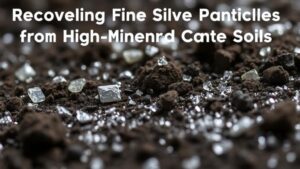Techniques for Recovering Gold from High-Clay Content Sediments
Techniques for Recovering Gold from High-Clay Content Sediments
The recovery of gold from high-clay content sediments poses unique challenges due to the physical properties and behavior of clay. Gold prospectors and miners face difficulties in separating gold particles from the surrounding clays, which can lead to reduced recovery rates. This article explores various techniques that can be utilized to effectively recover gold from sediments rich in clay.
Understanding Clay Interference in Gold Recovery
Clay minerals are fine-grained materials that can absorb water, swell, and adhere to gold particles, complicating the extraction process. presence of clay can lead to several problems, such as:
- Increased viscosity of slurries, which hinders the movement of gold particles.
- Adhesion of gold to clay particles, making physical separation difficult.
- Clogging of equipment due to clay buildup.
Understanding these challenges is critical for developing effective recovery strategies.
Techniques for Gold Recovery
1. Physical Separation Techniques
Physical separation techniques rely on the differences in size, shape, and density between gold and clay particles. Here are some methods:
- Panning: A traditional method that uses water to wash sediments in a pan. While effective for fine gold, clay can impede the process.
- Sluicing: This technique employs a sluice box that uses water flow to separate gold based on density. Pre-treatment to remove clay can enhance effectiveness.
- Shaking Tables: These tables use vibrations and water flow to separate gold from clay. But, they may require adjustments to accommodate high-clay content.
2. Chemical Separation Techniques
Chemical approaches often complement physical methods. These methods can disaggregate clay and improve gold recovery:
- Flocculation: The addition of flocculants (such as polyacrylamides) can help agglomerate clay particles, allowing for easier removal and enhancing gold recovery.
- Cyanidation: A widely-used method where cyanide is applied to extract gold from ore. Proper management of clay content during cyanidation is necessary due to potential complications.
3. Combination of Techniques
Combining physical and chemical methods can often yield better results. For example, a two-step process that involves:
- Initial Clay Removal: Utilizing flocculation to reduce clay content followed by physical methods for gold recovery.
- Final Chemical Treatment: After physical recovery, applying chemical methods like cyanidation to extract remaining gold.
Case Studies and Real-World Applications
Several mining operations have effectively implemented these techniques. For example:
- The Minera Alamos Project: In Mexico, flocculation was successfully used to reduce clay content, resulting in a 20% increase in gold recovery rates.
- Barrick Golds Operations: By optimizing sluicing processes and utilizing chemical treatments, Barrick has reported significant improvements in gold extraction from high-clay sediments.
Challenges and Considerations
While several techniques exist, each comes with its own set of challenges:
- Environmental concerns regarding chemical usage in gold recovery.
- Economic feasibility, especially for small-scale miners who may face higher costs.
- The need for ongoing research and innovation to improve existing techniques for better efficiency.
Conclusion
Recovering gold from high-clay content sediments requires a nuanced understanding of both the materials involved and the techniques available. By employing a combination of physical and chemical methods, gold miners can improve recovery rates and reduce the inefficiencies associated with clay interferences. As mining technologies advance, the integration of new techniques will likely continue to enhance the effectiveness of gold recovery from challenging sediment conditions.
Actionable takeaways include:
- Evaluate the sediment composition before deciding on a recovery strategy.
- Consider using flocculation to improve sediment treatment efficiency.
- Stay informed about emerging technologies in gold recovery to optimize processes.


